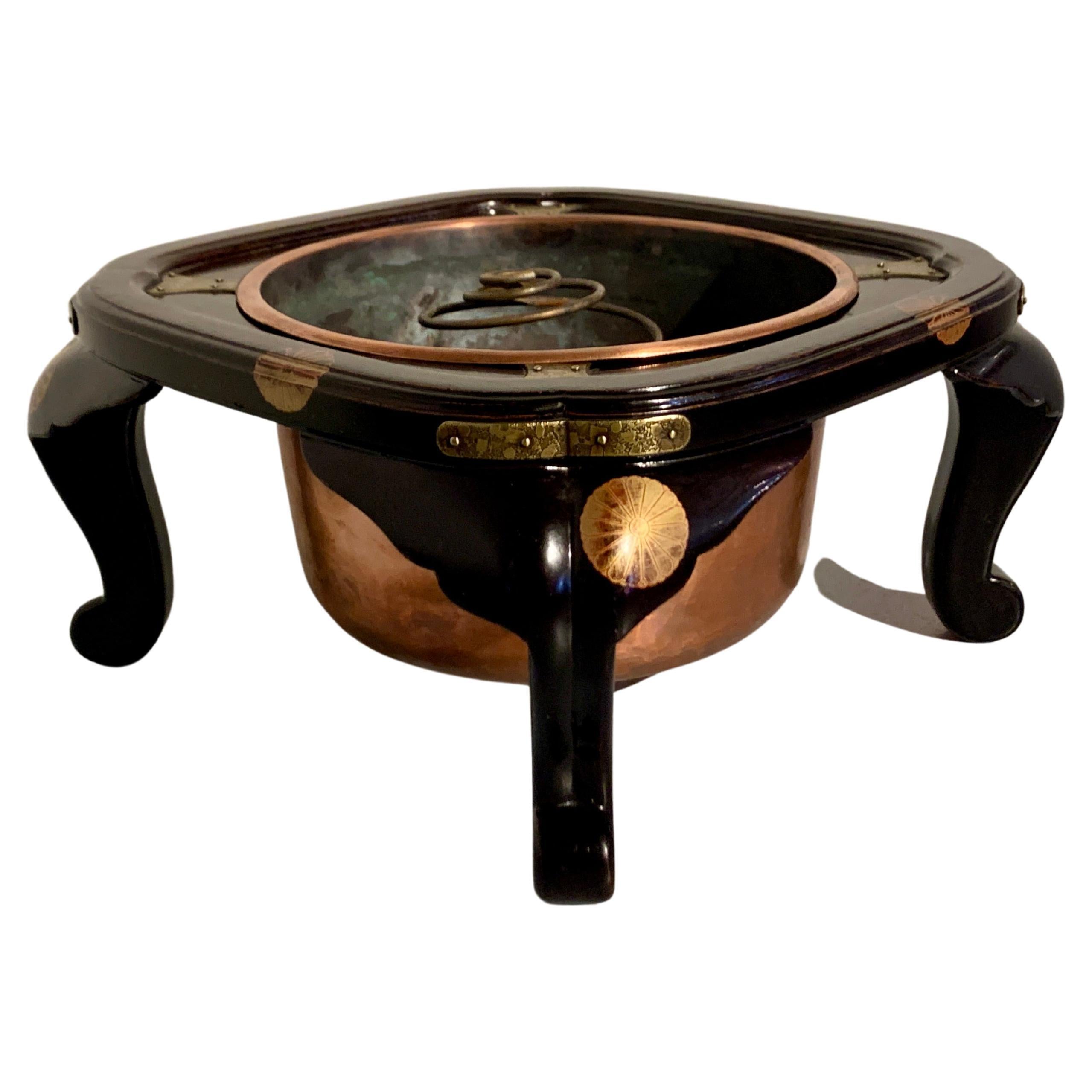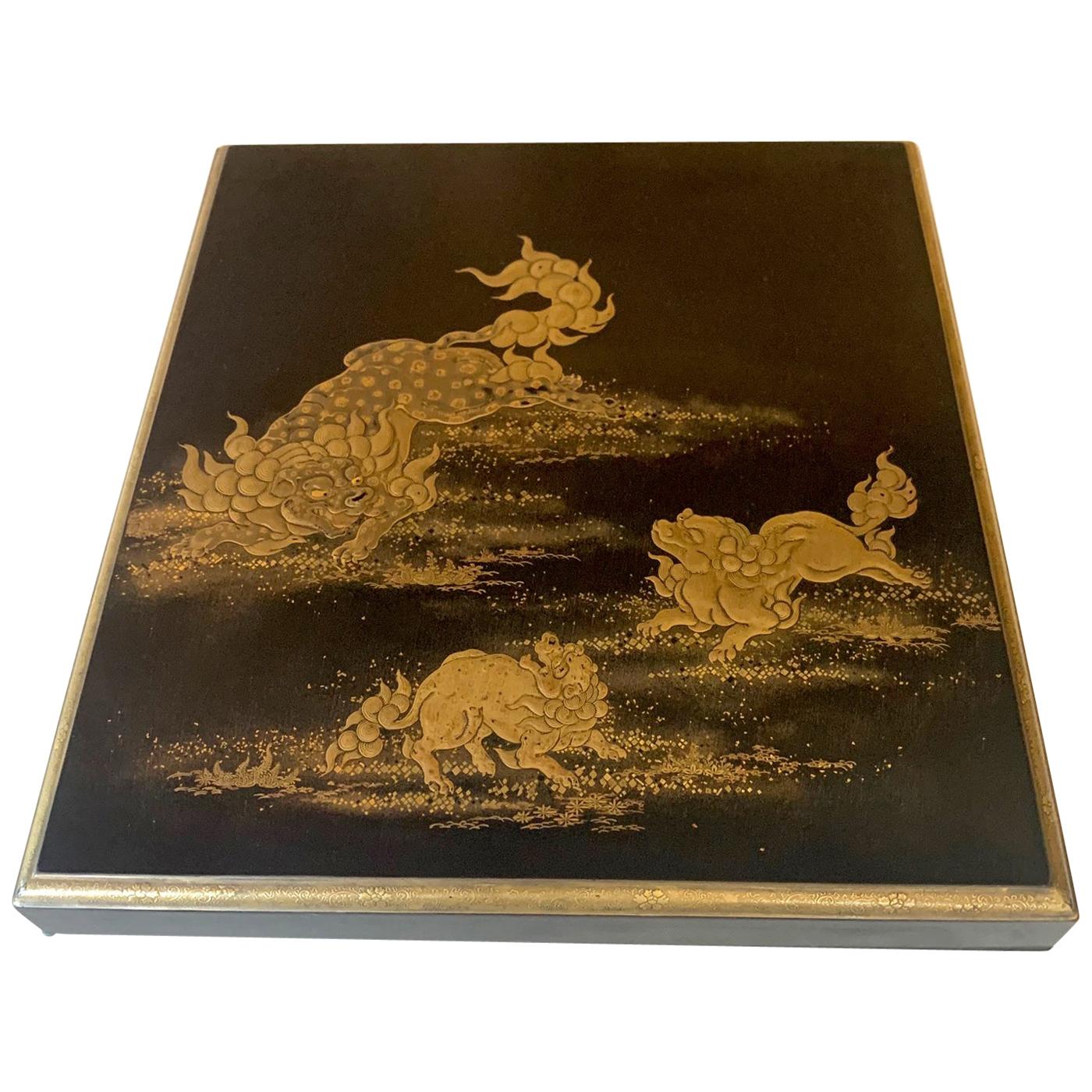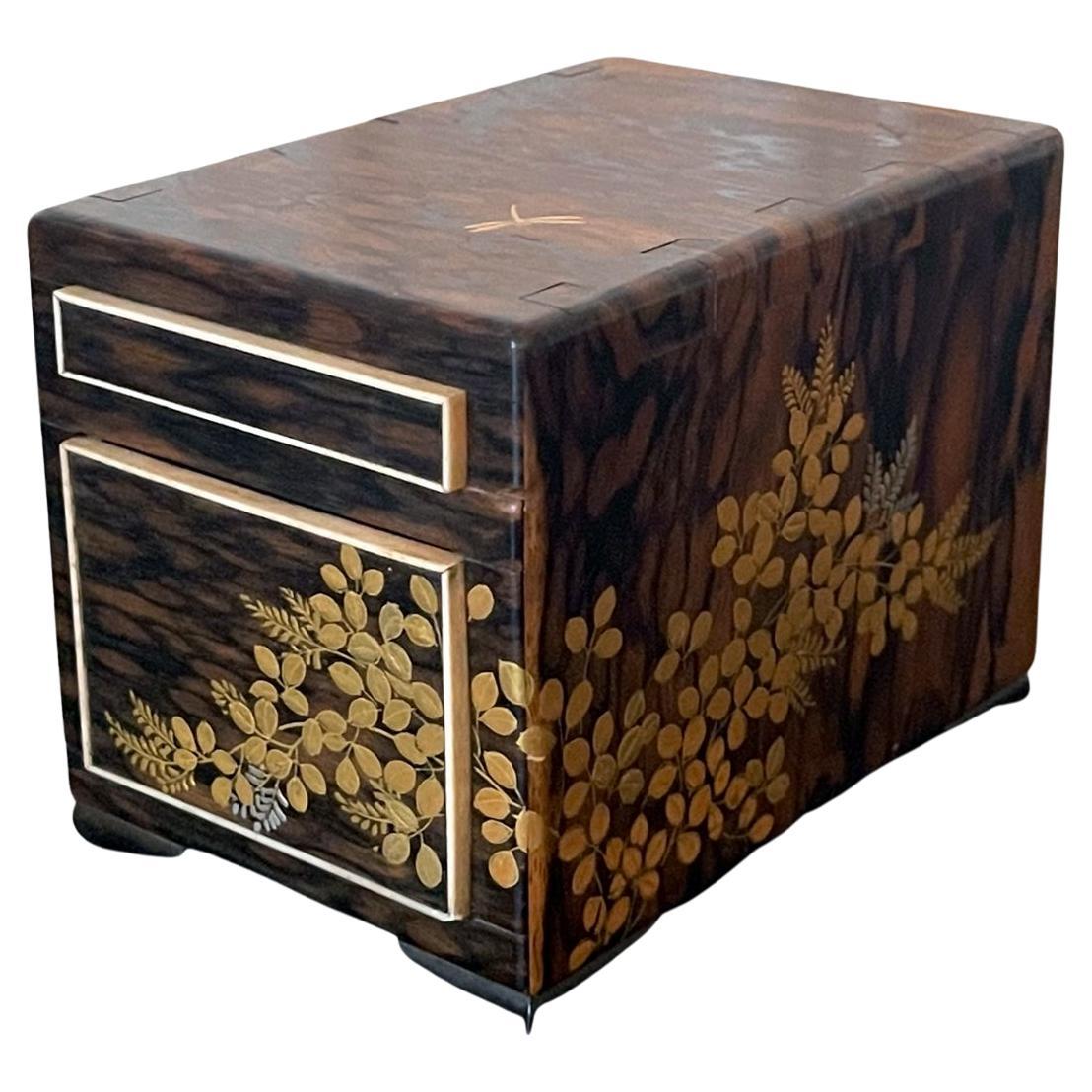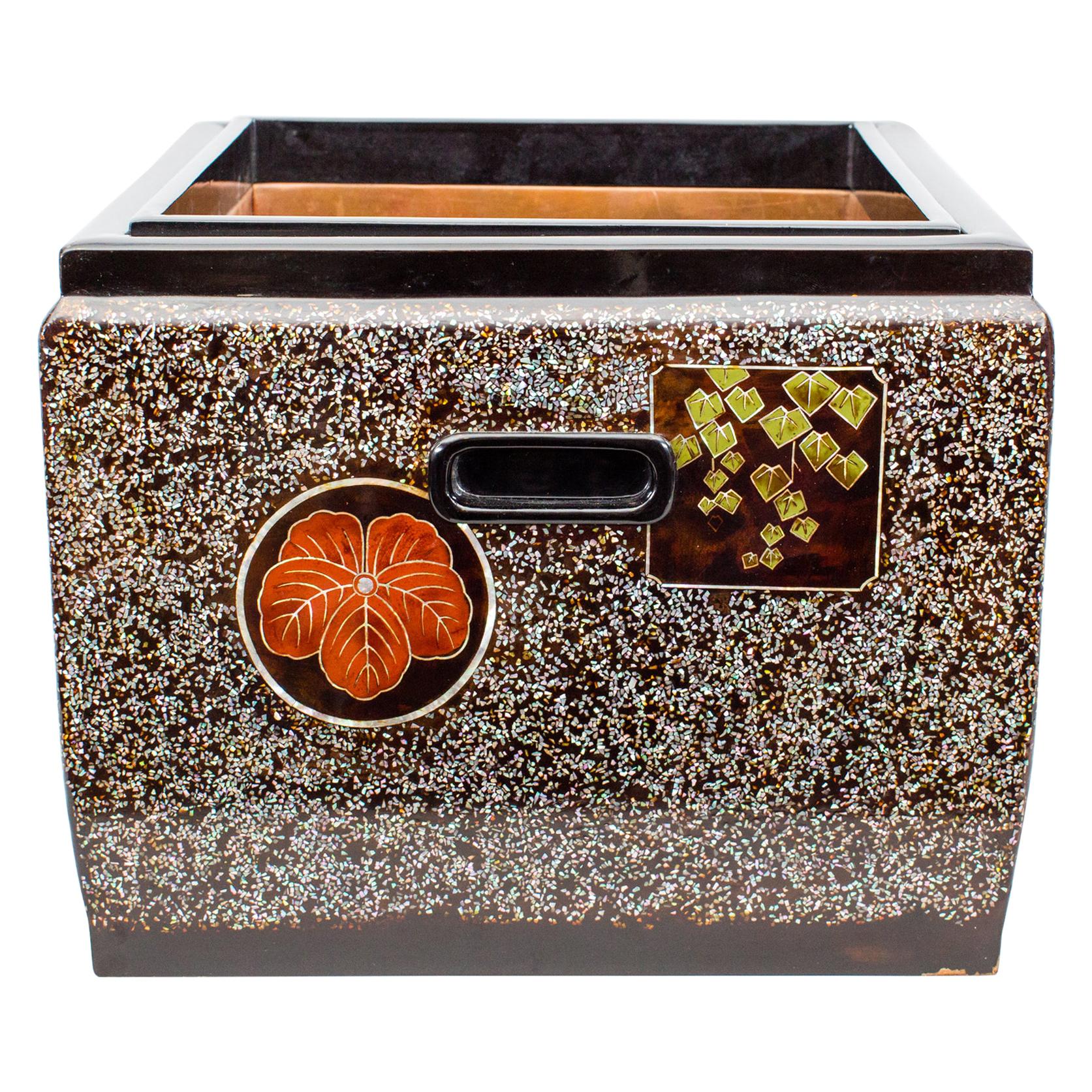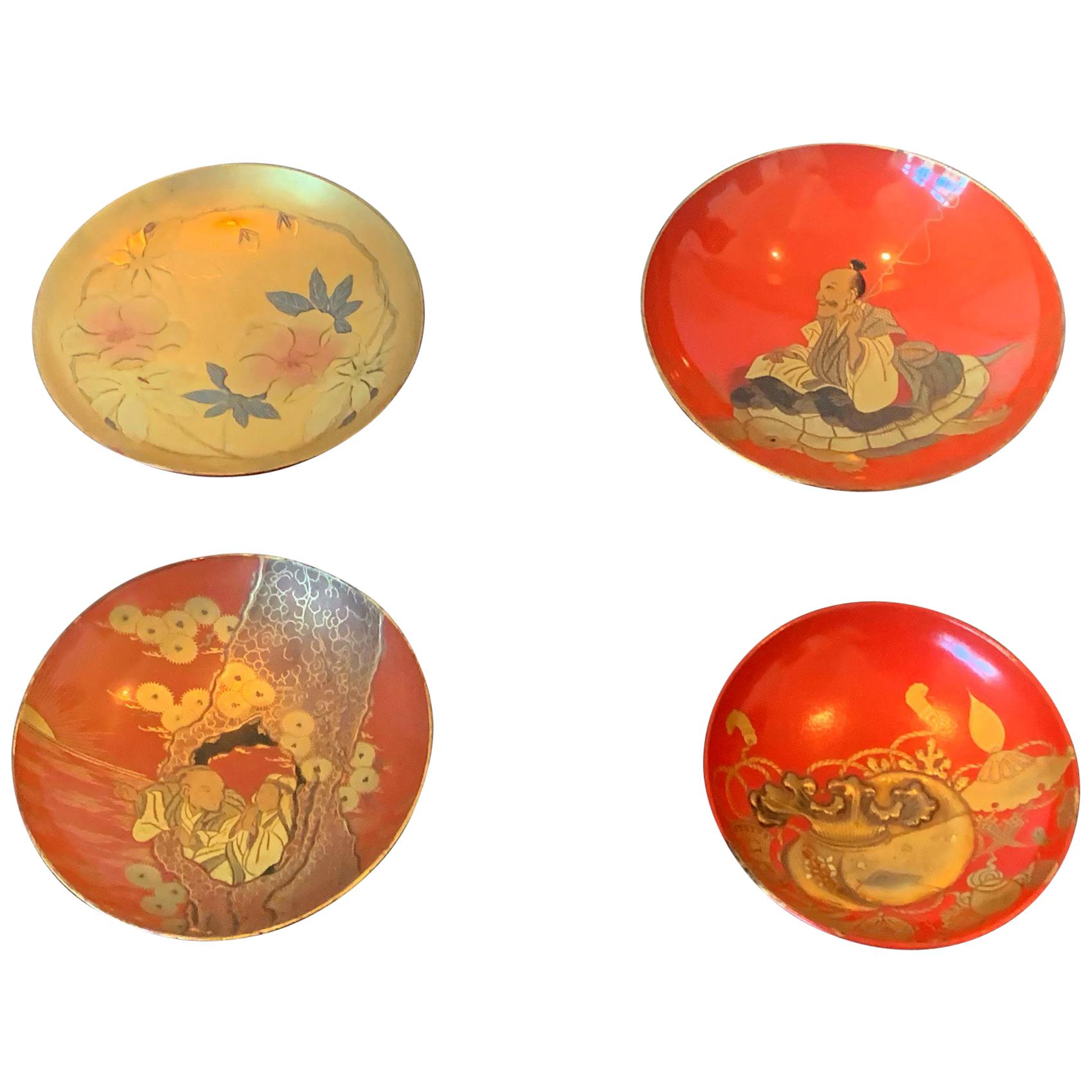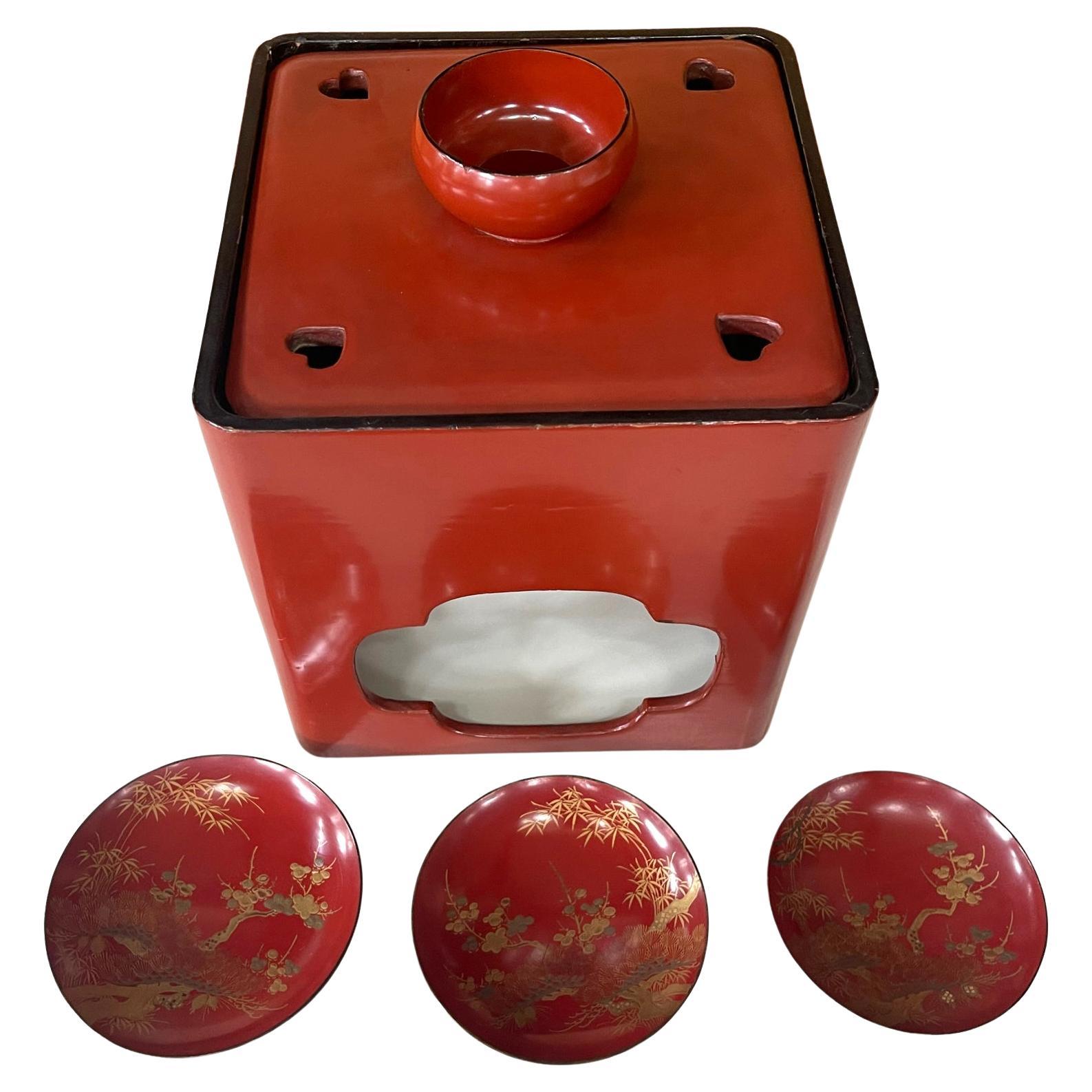Items Similar to Fine Japanese Hibachi Lacquer with Inlays Meiji Period
Want more images or videos?
Request additional images or videos from the seller
1 of 14
Fine Japanese Hibachi Lacquer with Inlays Meiji Period
About the Item
A fine Japanese wood Hibachi with copper insert circa 1900-30s end of Meiji to Taisho Period. It can be used as a unique planter or to showcase an ikebana design.
Hibachi means "fire bowl" in Japanese and its origin dates back to Heian Period. It was traditionally used as a heating device with the ash and coal placed in the insert container. In late Meiji period, it started to be used as an occasional device to heat the water for tea or small pieces of food.
The Hibachi on offer was made from paulownia wood with its expressive grain pattern (it was carved and turned out of a tree trunk). The surface was decorated with a lovely image with a pair of young birds next to a cluster of grasses and flowers at the edge of a water. The floral petals were inlays with mother of pearl. The back side was decorated with a scrolling vine pattern. It has a copper insert which shows age-related patina.
- Dimensions:Height: 7.5 in (19.05 cm)Diameter: 10 in (25.4 cm)
- Style:Meiji (Of the Period)
- Materials and Techniques:
- Place of Origin:
- Period:
- Date of Manufacture:1900-30s
- Condition:Wear consistent with age and use. Good condition, surface well lacquered and shows only minor nicks, marks and scratches. Copper insert shows wear and patina expected from age and some gentle use.
- Seller Location:Atlanta, GA
- Reference Number:1stDibs: LU945039769702
About the Seller
5.0
Platinum Seller
These expertly vetted sellers are 1stDibs' most experienced sellers and are rated highest by our customers.
Established in 2006
1stDibs seller since 2010
484 sales on 1stDibs
Typical response time: <1 hour
- ShippingRetrieving quote...Ships From: Atlanta, GA
- Return PolicyA return for this item may be initiated within 2 days of delivery.
More From This SellerView All
- Japanese Lacquer Box with Fine Maki-e Decoration Meiji PeriodLocated in Atlanta, GAA lacquered wood box with lid from Japan circa 19th century Meiji Period. The finely decorated box was used to store paper slips and small documents on the desk. It is overall finished with black lacquer (kuro) with sparse Mura-Nashiji effect outside and on the top surface of the lid, there are three Komainu, (sometimes known as Shishi or Japanese lions) frolicking and forming a circle in lively motion. Komainu are auspicious animals in Japanese cultures in both Shinto and Buddhism tradition. Originally from China, these animals symbolizes guardians to ward off evil spirits. Hiramaki-e was used in combination with carving and combing to render the lions with various surface textures. A gilt border with an slight angle was given to the lid and even the thin band is decorated with miniature floral scrolls. The interior of the box was finished in a dense nashiji. Underneath the lid, a cluster of peonies open lavishly by two gentle mounts. Takamaki-e (high relief) in both gold and silver were...Category
Antique Late 19th Century Japanese Japonisme Lacquer
MaterialsWood, Lacquer
- Fine Miniature Japanese Kodansu with Lacquer InlaysLocated in Atlanta, GAA fine Japanese miniature kodansu constructed from Kaki wood (Persimmon) circa 19th century, late Meiji period. With its expressive exotic wood grains and exposed tenon construction,...Category
Antique Late 19th Century Japanese Meiji Lacquer
MaterialsWood
- Four Japanese Lacquered Sake Cups Meiji PeriodLocated in Atlanta, GAAn assemble of four lacquerware sake cups from Meiji period Japan circa late 19th century. The shadow cups on an elevated stem were used by the nobles during ...Category
Antique Late 19th Century Japanese Meiji Lacquer
MaterialsWood, Lacquer
- Japanese Lacquered Sake Drinking Set Meiji PeriodLocated in Atlanta, GAA Japanese lacquered Sake Drinking set circa late 19th century (end of Meiji period), The assemble consists of a red lacquer stand open frame support and a lid that encloses a storage space with black lacquered interior. The lid features a and a cup holder in the center and four heart shape cutouts on the corners. There are three maki-e decorated sake cups with gradual sizes. The cups showcase on the red background elaborate gold hiramaki-e paintings...Category
Antique Late 19th Century Japanese Meiji Lacquer
MaterialsWood, Lacquer
- Japanese Lacquered Gold Maki-E Naga Fubako Meiji PeriodLocated in Atlanta, GAA Japanese lacquered wood Naga Fubako (a long box used to store document or large scroll painting), circa 19th century Meiji period. The rectangular box features an unusually deep lipped lid with slightly rounded corners, a conforming lower box with bronze medallion rings with tasseled...Category
Antique 19th Century Japanese Meiji Lacquer
MaterialsWood, Lacquer
- Fine Japanese Lacquered Inro with Inlays by KajikawaLocated in Atlanta, GAA Japanese four-case lacquer inro by a member of Kajikawa family circa 19th century (late Edo to early Meiji period). It depicts a nocturnal scenery of a meandering stream surrounded by bush clovers, where a full moon is reflected on the water. It was masterfully decorated in gold and silver maki-e using a combination of techniques including takamakie, togidashi and kirigane as well as aogai (abalone shell) inlays. The stream was set between the slightly elevated banks, adding to this piece a already strong three-dimensional composition. The interior was decorated in gold nashiji. It was signed on the bottom "Kajikawa Zou" (made by Kajikawa and a pot seal centered with "Ei" in Kanji. In one of the compartment, there is a katakana mark, appears to be a name, possibly the owner. Kajikawa clan was one of the most famous lacquer artisanal family established in the 17th century. Many well known members over the generations produced lacquer art in a wide range of formats, but two third were signed only with the family name such as this one. It is therefore not possible to pinpoint the exact author of this piece. Provenance: This inro was purchased as lot 349 in Christie's New York sale Japanese...Category
Antique 19th Century Japanese Japonisme Lacquer
MaterialsShell, Wood, Lacquer
You May Also Like
- Japanese Lacquer Hibachi with Imperial Chrysanthemum, Meiji Period, JapanLocated in Austin, TXA simple and elegant Japanese lacquer hibachi stand with imperial chrysanthemum mon and copper liner, now modified as an usubata, late Meiji Period, ci...Category
Antique Early 1900s Lacquer
MaterialsCopper
- Japanese Lacquer Hibachi (Brazier)Located in Hudson, NYJapanese Lacquer Hibachi (Brazier), Meiji period (1868 - 1912) Box- shaped Japanese hibachi with mother of pearl inlay, handles on two sides, and a cop...Category
Antique 1880s Japanese Meiji Lacquer
MaterialsCopper
- Japanese Meiji Period Lacquer Six Drawer InroLocated in Newark, EnglandThe Inro is decorated with a gold lacquer base and features mother of pearl shell inlay leaves surounding wheeled cart with foliage. The Inro with a slide action opening which hides ...Category
Antique Late 19th Century Japanese Meiji Lacquer
MaterialsRope, Lacquer
- Japanese Red Lacquer Hibachi, c. 1900Located in Chicago, ILDesigned to hold glowing embers, hibachi vessels were used for cooking or as a source of heat in Japanese homes. Placed under a low wood kotatsu table wi...Category
Early 20th Century Japanese Meiji Lacquer
MaterialsCopper
- Japanese Maki-e Lacquer Stacking Box, Jubako, Meiji Period, JapanLocated in Austin, TXA fine and impressive Japanese gold maki-e decorated black lacquer five-tier jubako with presentation tray, two lids, and the original tomobako storage box, Meiji period, late 19th c...Category
Antique Late 19th Century Japanese Meiji Lacquer
MaterialsLacquer
- Japanese Meiji Period Antique Lacquer Box with Gold Maki-e DecorationLocated in New York, NYA fine antique Japanese Meji Period lacquer box decorated with a fan and a stylized star shaped window in the maki-e technique. The fan at the top right corner, fully opened depictin...Category
Antique 19th Century Japanese Meiji Lacquer
MaterialsLacquer
